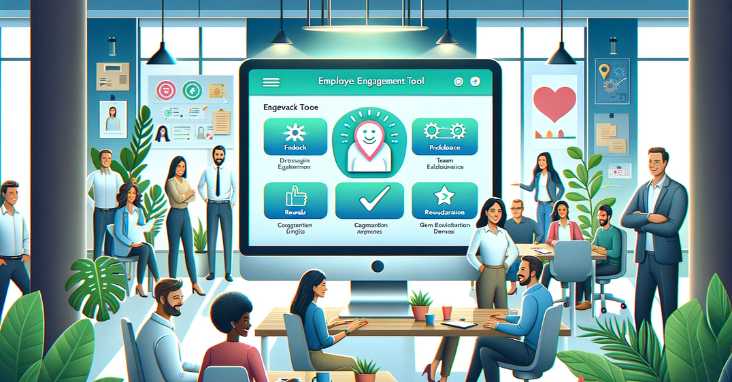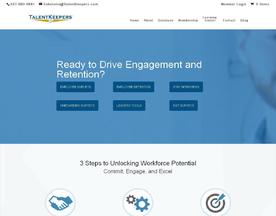How can a employee engagement tool boost morale in the workplace? Employee engagement tools boost morale by enhancing communication, recognizing achievements, promoting work-life balance, and supporting professional growth
Employee engagement is a critical aspect of any successful organization, and it is directly linked to employee satisfaction, productivity, and retention. Companies that prioritize employee engagement have a competitive edge over those that do not, and this has led to the development of various employee engagement tools. These tools are designed to help organizations measure and improve employee engagement levels, and they come in different forms, including software platforms, surveys, and feedback systems.

Employee engagement tools provide a range of features that help organizations understand their employees’ needs, preferences, and challenges. They enable managers to measure employee engagement levels, identify areas that need improvement, and implement targeted interventions. Some of the key features of employee engagement tools include pulse surveys, real-time feedback, performance analytics, and personalized recommendations. These features help organizations create a more engaged workforce by addressing the specific needs of their employees.
Key Takeaways
- Employee engagement is a critical aspect of organizational success, and employee engagement tools are designed to help organizations measure and improve engagement levels.
- Employee engagement tools provide a range of features, including pulse surveys, real-time feedback, performance analytics, and personalized recommendations, which help organizations create a more engaged workforce.
- Employee engagement tools are available in different forms, including software platforms, surveys, and feedback systems, and they can be used to improve employee satisfaction, productivity, and retention.
Understanding Employee Engagement
Employee engagement refers to the level of commitment, passion, and loyalty that employees have towards their jobs and the organization they work for. It is a critical aspect of the workplace that can significantly impact employee satisfaction, morale, and productivity.
Importance of Engagement
Employee engagement is crucial for the success of any organization. Engaged employees are more likely to be productive, innovative, and committed to the goals and objectives of the organization. They are also more likely to stay with the organization for the long-term, reducing turnover rates and associated costs.
On the other hand, disengaged employees can have a negative impact on the workplace. They may be less productive, less committed, and more likely to leave the organization. They may also have a negative impact on the morale of other employees, reducing overall productivity and job satisfaction.
Measuring Engagement Levels
Measuring employee engagement levels is essential to understanding the current state of engagement within an organization. There are several methods for measuring engagement levels, including surveys, focus groups, and interviews.
Employee engagement surveys are a popular method for measuring engagement levels. These surveys typically ask employees a series of questions related to their job satisfaction, work environment, and overall engagement with the organization. The results of these surveys can provide valuable insights into the areas in which the organization is excelling and the areas in which it needs to improve.
In conclusion, understanding employee engagement is critical to the success of any organization. By focusing on employee engagement, organizations can improve productivity, reduce turnover rates, and create a positive work environment for their employees.
Here is a link to the State of the American Workplace Report 2017, which provides valuable insights into employee engagement levels in the United States.
Features of Employee Engagement Tools
Employee engagement tools are designed to improve employee satisfaction, productivity, and retention. These tools offer a range of features to help organizations measure, analyze, and improve employee engagement. Some of the key features of employee engagement tools are discussed below.
Surveys and Polls
Surveys and polls are a common feature of employee engagement tools. These tools allow organizations to gather feedback from employees on a regular basis. Engagement surveys and pulse surveys are two types of surveys commonly used by organizations to measure employee engagement.
Engagement surveys are typically conducted once or twice a year and are designed to measure overall employee engagement. Pulse surveys, on the other hand, are shorter surveys that are conducted more frequently (e.g., weekly or monthly) to track changes in employee engagement over time.
Recognition and Rewards
Recognition and rewards are important for employee engagement and motivation. Many employee engagement tools offer features for recognizing and rewarding employees for their achievements and contributions. These features can include badges, points, and other forms of recognition.
Analytics and Reporting
Analytics and reporting features are essential for measuring and analyzing employee engagement data. These features allow organizations to track trends, identify areas for improvement, and measure the impact of engagement initiatives. Employee engagement tools may offer various types of reports, such as engagement scorecards, benchmarking reports, and action planning reports.
Communication and Feedback
Communication and feedback are critical for employee engagement. Many employee engagement tools offer features for facilitating communication and feedback between employees and managers. These features can include chat, messaging, and other communication channels.
Integration Capabilities
Integration capabilities are important for employee engagement tools to work seamlessly with other HR systems and tools. Many employee engagement tools offer integrations with popular HR systems such as HRIS, ATS, and LMS. These integrations can help organizations automate processes and streamline workflows.
Overall, employee engagement tools offer a range of features to help organizations measure, analyze, and improve employee engagement. By using these tools, organizations can create a more engaged and productive workforce, which can lead to improved business outcomes.
One example of an employee engagement tool with high authority in the market is Glint, which offers a comprehensive set of features for measuring and improving employee engagement.
Software Platforms for Engagement
When it comes to employee engagement, software platforms can be a powerful tool for organizations to keep their employees motivated and productive. The right platform can help companies to manage their employees’ needs, track their progress, and provide them with the necessary support to succeed.
Choosing the Right Platform
Choosing the right platform can be a daunting task, with so many options available in the market. However, it is important to select a platform that aligns with the company’s goals and culture. The platform should be user-friendly, customizable, and scalable. It should also provide the necessary features to meet the organization’s needs.
Popular Engagement Software
There are many software platforms available in the market that can help organizations to engage their employees. Some of the popular engagement software platforms are:
-
15Five: 15Five is a performance management software that helps organizations to give feedback, set goals, and track progress. It provides a platform for employees to share their thoughts and ideas with their managers.
-
Culture Amp: Culture Amp is an employee feedback and analytics platform that helps organizations to measure and improve their company culture. It provides a platform for employees to give feedback on their work experience.
-
Officevibe: Officevibe is a platform that helps organizations to measure and improve their employee engagement. It provides a platform for employees to give feedback on their work experience.
-
Motivosity: Motivosity is a platform that helps organizations to recognize and reward their employees. It provides a platform for employees to give and receive recognition.
-
Empuls: Empuls is a platform that helps organizations to engage and motivate their employees. It provides a platform for employees to give feedback, set goals, and track progress.
-
Tinypulse: Tinypulse is a platform that helps organizations to measure and improve their employee engagement. It provides a platform for employees to give feedback on their work experience.
-
Bonusly: Bonusly is a platform that helps organizations to recognize and reward their employees. It provides a platform for employees to give and receive recognition.
-
Leapsome: Leapsome is a platform that helps organizations to manage their employees’ performance and development. It provides a platform for employees to set goals, receive feedback, and track progress.
Organizations should choose a platform that aligns with their goals and culture. It is important to select a platform that provides the necessary features to meet the organization’s needs.
For more information on employee engagement software platforms, check out this link.
The Role of Leadership in Engagement

Effective leadership is crucial for employee engagement. Leaders play a critical role in creating a culture of engagement within an organization. In this section, we will discuss the importance of leadership in engagement, and explore two key aspects of leadership that can impact engagement: managers as engagement leaders and leadership communication.
Managers as Engagement Leaders
Managers play an essential role in employee engagement. They are the ones who interact with employees on a daily basis and are responsible for setting expectations, providing feedback, and recognizing good work. Managers who are engaged themselves are more likely to have engaged employees. Therefore, it is essential to provide managers with the tools and resources they need to foster engagement among their teams.
One way to do this is by providing training and development opportunities for managers. This can include coaching, mentoring, and leadership development programs. By investing in their development, organizations can ensure that managers have the skills and knowledge needed to create an engaged workforce.
Leadership Communication
Effective communication is another critical aspect of leadership that can impact engagement. Leaders must communicate clearly and consistently to build trust and create a sense of transparency within the organization. This can include communicating the organization’s vision, mission, and values, as well as providing regular updates on company performance and progress.
Leadership communication can also involve soliciting feedback from employees and responding to their concerns. By actively listening to employees and addressing their feedback, leaders can demonstrate that they value their contributions and are committed to creating a positive work environment.
To learn more about the role of leadership in engagement, check out this resource.
Employee Experience and Onboarding

Employee experience and onboarding are crucial components of employee engagement. A positive employee experience can lead to greater job satisfaction, increased productivity, and better employee retention. Onboarding processes, in particular, play a critical role in shaping the employee experience.
Onboarding Processes
Effective onboarding processes can help new employees integrate into the company culture, understand their roles and responsibilities, and feel supported in their new position. This can lead to a smoother transition and a more positive experience overall.
One key aspect of successful onboarding is providing new employees with the necessary training and resources to perform their job duties. This can include training on company policies and procedures, as well as specific job-related skills and knowledge. By providing comprehensive onboarding, employees are more likely to feel confident and capable in their new role.
Another important factor is socialization. New employees should be introduced to their colleagues and given opportunities to build relationships with their coworkers. This can help them feel more connected to the company and its culture, leading to greater job satisfaction and retention.
Continuous Learning and Development
In addition to effective onboarding processes, continuous learning and development opportunities are also important for employee engagement. By providing ongoing training and development, employees can continue to grow and develop their skills, which can lead to greater job satisfaction and career advancement.
One way to facilitate continuous learning is to provide employees with access to online training resources and courses. This can allow employees to learn at their own pace and on their own schedule, which can be particularly beneficial for remote workers.
Another approach is to offer regular training and development sessions, either in-person or virtually. These sessions can cover a range of topics, from technical skills to leadership development, and can help employees stay up-to-date with the latest industry trends and best practices.
Overall, a focus on employee experience and onboarding, as well as continuous learning and development, can help companies create a more engaged and productive workforce. By investing in these areas, companies can improve employee retention and ultimately drive business success.
Here is a great resource from the Society for Human Resource Management on effective onboarding processes.
Performance and Productivity

Employee engagement tools can have a significant impact on the performance and productivity of employees. By providing employees with the tools they need to succeed, employers can ensure that their workforce is performing at their best.
Performance Reviews and Management
Performance reviews are a critical part of performance management. They allow managers to provide feedback to employees on their performance, identify areas for improvement, and set goals for the future. With the help of employee engagement tools, managers can streamline the performance review process, making it easier to provide feedback and assess employee performance.
One such tool is 15Five, which allows managers to conduct weekly check-ins with employees, providing them with an opportunity to discuss their progress and receive feedback in a timely manner. By providing regular feedback, managers can help employees stay on track and improve their performance.
Setting and Tracking Goals
Setting and tracking goals is another essential part of performance management. With the help of employee engagement tools, employers can set goals for their employees and track their progress towards achieving them.
One such tool is BetterWorks, which allows employers to set goals for their employees and track their progress in real-time. By providing employees with clear goals and a way to track their progress, employers can help them stay motivated and focused on achieving their objectives.
Overall, employee engagement tools can help employers improve the performance and productivity of their workforce. By providing employees with the tools they need to succeed, employers can ensure that their workforce is performing at their best.
Building Company Culture

Creating a positive company culture is essential to employee engagement and satisfaction. A strong company culture can lead to higher morale, increased productivity, and a more collaborative work environment. Here are some key ways to build a positive company culture:
Fostering Team Collaboration
Encouraging team collaboration is a great way to build a positive company culture. When team members work together, they can share ideas and knowledge, leading to increased innovation and problem-solving. To foster collaboration, companies can implement tools like project management software or team communication platforms. These tools allow team members to work together more efficiently and effectively, even if they are working remotely.
Promoting Transparency and Trust
Transparency and trust are crucial components of a positive company culture. When employees feel that they can trust their managers and colleagues, they are more likely to be engaged and motivated. Companies can promote transparency by sharing information about company goals, financial performance, and other key metrics. This can be done through regular company-wide meetings or by implementing an intranet or other internal communication platform.
To build trust, companies can also implement policies that promote fairness and equality. For example, offering equal pay for equal work and providing opportunities for professional development can help employees feel valued and respected.
Overall, building a positive company culture takes time and effort, but the benefits are well worth it. By fostering collaboration and promoting transparency and trust, companies can create a work environment that is engaging, productive, and fulfilling for all team members.
Here is an external resource with more information on building a positive company culture.
Employee Retention Strategies

Employee retention is a critical aspect of any business that wants to maintain a competitive edge. High turnover rates can be costly and can also negatively impact the morale of the remaining employees. Therefore, it is important to implement effective employee retention strategies. This section will explore some of the strategies that businesses can use to retain their top talent.
Understanding Turnover
Before implementing any employee retention strategies, it is important to understand the reasons behind employee turnover. Some of the common reasons for turnover include lack of growth opportunities, poor management, low pay, and lack of recognition. By identifying the reasons behind turnover, businesses can tailor their retention strategies to address the specific needs of their employees.
Incentives and Growth Opportunities
One of the most effective employee retention strategies is to provide incentives and growth opportunities. This can include things like offering competitive salaries, providing regular performance evaluations, and offering opportunities for career advancement. By providing employees with incentives and growth opportunities, businesses can create a sense of loyalty and commitment among their employees.
Another effective strategy is to provide employees with training and development opportunities. This can include things like on-the-job training, mentorship programs, and tuition reimbursement. By investing in the development of their employees, businesses can create a sense of loyalty and commitment among their employees.
External Resource
For more information on employee retention strategies, check out this article from the Society for Human Resource Management.
Advancements in Engagement Technology

As technology continues to advance, so do the tools available for employee engagement. Companies are constantly looking for ways to improve employee satisfaction and retention, and these advancements in engagement technology are helping them achieve those goals.
Machine Learning and AI
One of the most exciting advancements in engagement technology is the use of machine learning and AI. These technologies can help companies analyze large amounts of data to identify patterns and trends that may not be immediately apparent. This can help companies make more informed decisions about employee engagement, such as which benefits are most valued by employees or which managers are most effective at retaining staff.
AI-powered chatbots are also becoming more common in HR tools, allowing employees to get answers to their questions quickly and easily. These chatbots can be programmed to answer common questions about benefits, company policies, and more, freeing up HR staff to focus on more complex issues.
Automation and Scheduling Tools
Another area of engagement technology that has seen significant advancements is automation and scheduling tools. These tools can help reduce the administrative burden on HR staff, allowing them to focus on more strategic initiatives.
Automations can be used to streamline processes such as onboarding and offboarding, making the experience smoother and more efficient for both employees and HR staff. Scheduling tools can also be used to help employees manage their time more effectively, ensuring that they have enough time to complete their work while also taking breaks and managing their personal lives.
Overall, these advancements in engagement technology are helping companies improve employee satisfaction and retention. By leveraging the power of technology, companies can gain insights into what their employees need and want, and take action to meet those needs. With continued innovation in this area, the future of employee engagement looks bright.
Click here to learn more about the use of AI and ML in employee engagement.
Evaluating the Cost and ROI

Cost Analysis
When evaluating employee engagement tools, it is important to consider the cost and the potential return on investment (ROI). The cost of employee engagement tools can vary significantly depending on the capabilities and features offered. Some tools may have a one-time fee, while others may be subscription-based.
To accurately evaluate the cost of employee engagement tools, it is important to consider the specific needs of the organization. For example, a small business may only require basic features, while a larger corporation may need more advanced capabilities. It is also important to consider the number of employees who will be using the tool, as some tools charge per user.
To help with cost analysis, organizations can create a list of must-have features and compare the cost of different tools that meet those requirements. It may also be helpful to reach out to vendors for a customized quote based on the specific needs of the organization.
Benchmarking Success
In addition to cost analysis, it is important to evaluate the potential ROI of employee engagement tools. One way to measure ROI is through benchmarking. By establishing a baseline for employee engagement metrics, such as employee satisfaction and retention rates, organizations can track the impact of the tool over time.
To benchmark success, organizations can compare their employee engagement metrics to industry averages or to their own historical data. This can help identify areas for improvement and track progress over time.
It is important to note that the ROI of employee engagement tools may not be immediately apparent. It may take time for the tool to have a measurable impact on employee engagement metrics. However, by regularly tracking and analyzing data, organizations can gain insights into the effectiveness of the tool and make data-driven decisions.
To learn more about benchmarking and measuring the ROI of employee engagement tools, organizations can refer to resources such as this article from Forbes which provides insights and best practices for measuring the ROI of employee engagement initiatives.
Frequently Asked Questions

What are the key features to look for in an employee engagement platform?
When selecting an employee engagement platform, it is important to look for features that align with your organization’s goals and needs. Some key features to consider include:
- Customizable surveys and assessments
- Real-time data analytics and reporting
- Communication and collaboration tools
- Recognition and reward programs
- Learning and development opportunities
- Mobile accessibility
How can employee engagement activities boost workplace morale?
Engaging employees in meaningful activities can have a positive impact on workplace morale. Employee engagement activities can include team-building exercises, volunteer opportunities, wellness programs, and social events. These activities can help foster a sense of community and belonging, improve communication and collaboration, and boost overall job satisfaction.
What are some effective free tools available for enhancing employee engagement?
There are several free tools available that can help enhance employee engagement. Some popular options include:
- Slack for team communication and collaboration
- Trello for project management and task tracking
- Canva for creating visually appealing presentations and graphics
- Hootsuite for managing social media and promoting employee advocacy
- Zoom for virtual meetings and webinars
Which employee engagement tools are considered the best in the current market?
There are several employee engagement tools that are considered to be among the best in the current market. Some of these tools include:
- Culture Amp for employee feedback and analytics
- Qualtrics for survey and data analysis
- Glint for real-time employee engagement insights
- TINYpulse for pulse surveys and recognition programs
- Peakon for employee feedback and performance management
How do employee engagement apps contribute to organizational culture?
Employee engagement apps can contribute to organizational culture by promoting communication, collaboration, and feedback. These apps can help foster a culture of transparency and openness, where employees feel valued and heard. They can also help reinforce company values and promote a sense of shared purpose.
What techniques are most effective for conducting employee engagement surveys?
When conducting employee engagement surveys, it is important to use techniques that are effective and unbiased. Some techniques to consider include:
- Keeping surveys short and focused
- Using a mix of open-ended and closed-ended questions
- Ensuring anonymity and confidentiality
- Providing clear instructions and context
- Using benchmarking data to compare results
For more information on effective survey techniques, check out this resource.















